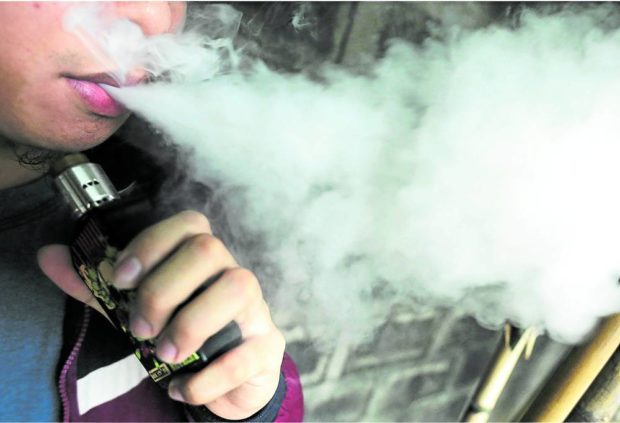UP study: Young Filipinos turning away from smoking, drinking

NEW CONCERN While noting reduced tobacco consumption among the Filipino youth, the study conducted by the University of the Philippines Population Institute said 16 percent of them have tried vaping, a more recently emerging concern for health experts. —GRIG C. MONTEGRANDE
The Filipino youth may be having a tougher time dealing with mental health issues, but they are veering away from vices such as smoking and drinking, the University of the Philippines Population Institute (UPPI) said in a nationwide survey released on Friday.
According to the 2021 Young Adult Fertility and Sexuality Study (YAFS5) of the UPPI, of every 10 young adult Filipinos, only three are currently drinking, one is smoking and close to none is using illegal drugs.
This means that the Filipino youth ages 15-24 are turning away from vices, the study suggests.
Around 20 million in the country make up this age group, including 9.8 million girls and 10.3 million boys.
The study finds that youth drug users were almost nil or at 0.1 percent in 2021.
Article continues after this advertisementThe figure significantly declined from the 2.4 percent recorded in 2002, the year when the Comprehensive Dangerous Drugs Act was passed.
Article continues after this advertisementSince 1994, the YAFS has been monitoring young Filipinos’ use of harmful substances, including alcohol, nicotine and illicit drugs.
The study also finds that while about a fifth of the youth were smoking between 1994 and 2013, the number declined to 12 percent in 2021.
The pandemic may have influenced young adults’ smoking behavior, too. The study said 41 percent of smokers are smoking fewer sticks now than during the pandemic, or an average of five sticks a day.
A similar trend was observed in drinking. Some 45 percent of youth surveyed said they were drinking less during the pandemic, while 65 percent said they want to stop drinking.
From 1994 to 2013, close to four in 10 youth were drinking, but the share declined to 29 percent in 2021.
‘Bold action’
The researchers attributed the decline to the “bold action” of government and civil society groups against illicit substances.
Lawmakers also passed the Sin Tax Law of 2012, which aims to curb consumption of tobacco and alcohol.
For instance, under the sin tax law, a cigarette stick now costs P4 to P7 each, while a small bottle of beer now costs P50 to P60 and P70 to P110 for the grande size.
The decline in substance use among the youth supplements the findings on young adults’ self-assessed health: 43 percent said they are of average health, 26 percent are very healthy, 22 percent are healthier than average and 9 percent are somewhat unhealthy.
The study sampled 10,949 youth from 974 barangays. The researchers then chose a target of 15 households in every sample barangay.
Factors behind shift
What influenced the changes in the youth’s lifestyle?
The researchers cited two key factors: the K-12 program of the Department of Education (DepEd), which has reconfigured the youth’s education and employment status, and the COVID-19 pandemic, which may have an effect on the youth’s schooling, work and activities.
Sociologist Ash Presto offered a similar theory, noting that there are many factors that can explain why young adults in the Philippines have veered away from those vices.
“There are pieces of evidence that show that young adults’ substance use has declined due to the COVID-19 pandemic for three reasons: first, because young people stayed home, and thereby got checked by their guardians more often; second, they were away from peer pressure that influences them to try out different substances; and third, being on lockdown made it harder for them to acquire these substances,” said Presto.
Moving forward from the survey’s findings, the sociologist said “we should look at the social factors” that influence young adult sexuality and overall health.
“Where are they getting these substances, where do they get their influences from and who keeps a check on them?” said Presto.
‘Emerging health risks’
While the latest data showed a “positive change in young people’s non-sexual risk behaviors,” the researchers have observed “emerging health risks.”
These include vaping, which has been tried by 16 percent of youth, and the rise of sedentary lifestyle among young adults.
When schools were closed in March 2020 to control the spread of the coronavirus, students nationwide turned to online or distance learning.
The setup continued for two years until the DepEd adopted a limited face-to-face learning modality this school year.
Before the pandemic, the study finds that the top five leisure activities of the youth involved physical interactions, such as meeting up with friends and playing sports. Other top activities included watching television or movies at home and texting and chatting with friends on social media.
Pandemic diversions
During the pandemic, their top five leisure activities are the following: going online and surfing the internet, texting or chatting with friends on social media, playing videos and online games, watching television and movies at home, and sleeping or resting.
YAFS5 aims to aid the Adolescent Health and Development Strategic Plan of the Department of Health (DOH), including DepEd’s Comprehensive Sexuality Education and a joint DepEd-DOH program on improving youth mental health. The program was piloted in 1,000 schools nationwide in 2020 and would continue till 2023.
The full YAFS5 report was relased to the public by the UPPI on Friday. On Monday, the institute released its findings about the state of the youth’s mental health, citing the prevalence of depression and suicidal thoughts among them.
Previous findings of the nationwide survey were published in 1982, 1994, 2002 and 2013. INQ
READ: Pandemic habits? DOH survey shows 40% of Filipinos drink alcohol, 15% smoke tobacco